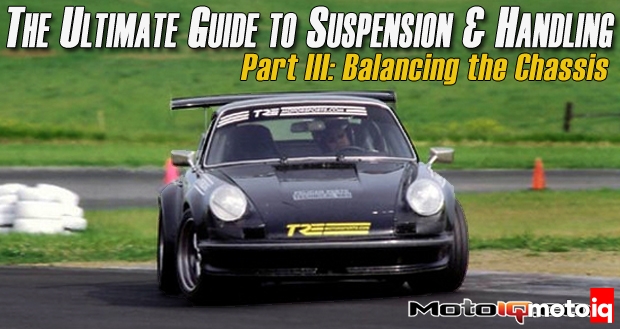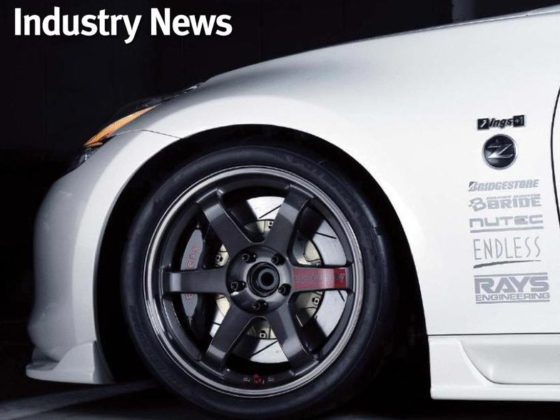,
 In a corner, the car will roll toward the outside of the turn, transferring weight to the outboard wheels. Suspension tuning has all to do with manipulating this weight transfer with springs, shocks and antisway bars.
In a corner, the car will roll toward the outside of the turn, transferring weight to the outboard wheels. Suspension tuning has all to do with manipulating this weight transfer with springs, shocks and antisway bars.Changing the spring rate and anti-roll bar torsional rate has a large impact on slip angle. Running a stiffer spring or anti-roll bar on one end of a car will cause more weight to be transferred onto the outside tire as the car tries to roll in a corner. The softer end of the car will compress and the more stiffly sprung end will resist compressing putting more load into that tire causing it to run at a bigger slip angle. So for your theoretical understeering, front-wheel-drive car you can run a bigger rear anti-roll bar, stiffer springs or both to tune out understeer. Conversely, stiffening the front suspension and increasing the rear tire pressures can help tame an oversteering car.
 Selecting larger antisway bars or adding an antisway bar where none was before not only reduces roll on a corner but changing the ratio of stiffness allows tuning of the weight transfer affecting under and oversteer. Adjustable sway bars are perhaps the most effective tuning tool for the average guy. These Progress Group swaybars are three way adjustable.
Selecting larger antisway bars or adding an antisway bar where none was before not only reduces roll on a corner but changing the ratio of stiffness allows tuning of the weight transfer affecting under and oversteer. Adjustable sway bars are perhaps the most effective tuning tool for the average guy. These Progress Group swaybars are three way adjustable.Shocks can improve response and help with balancing the car. Adjustable shocks can be a powerful chassis tuning device as well. As an example soft shocks get the car to a steady point of weight transfer faster right after the initiation of a turn. When set stiff they will delay weight transfer. Thus shocks affect how the car feels at turn in and also how it feels past mid turn. A car with the shocks set fairly hard will turn in sharply. If the shocks are set too hard, the car’s balance might change later in the turn in an unpredictable way as the heavy damping slows the body roll and weight transfer down. An analogy is that shocks are weight transfer capacitors.
 Putting the endlink in the closer holes increases the bar rate and putting it in the further holes reduces it. Unlike springs, adjustable bars can be quickly tuned at the track by someone of average mechanical skill.
Putting the endlink in the closer holes increases the bar rate and putting it in the further holes reduces it. Unlike springs, adjustable bars can be quickly tuned at the track by someone of average mechanical skill.Tires sizing can also affect chassis balance. Installing a wider tire on the end of the car that needs traction most is obvious. Rear engine Porsches have wider rear tires to help prevent oversteer. Powerful rear-wheel-drive cars also tend to have wider tires in the rear than in the front. Many front-wheel-drive autocrossers and road racers install a wider front tire to get more front grip.
 A major advantage of coilovers is that you can choose from a large selection of race springs to give you endless tuning options. Hyperco, Eibach and Swift all make top quality racing style springs.
A major advantage of coilovers is that you can choose from a large selection of race springs to give you endless tuning options. Hyperco, Eibach and Swift all make top quality racing style springs.What’s considered to be ideal by most performance drivers and suspension tuners is a car that is basically neutral when cornering without brake or throttle input. At the limit of adhesion, the car slides with all four wheels. Being able to provoke slight oversteer by lifting the throttle and more aggressive oversteer with slight braking while cornering at the limit is useful as well. Being able to slow rotation and reduce understeer with slight throttle application is good. This applies to both front- and rear-drive cars. Rear-wheel-drive cars should also be able to invoke oversteer with large applications of throttle. Balance like this gives the skilled driver the most options to control the car at the limit of traction when driving.
| Stiffer | Softer | ||
| Front Antisway Bar | More Understeer | Less Understeer | |
| Rear Antisway Bar | More Oversteer | Less Oversteer | |
| Front Spring | More Understeer | Less Understeer | |
| Rear Spring | More Oversteer | Less Oversteer | |
| Front Tire Pressure* | Less Understeer | More Understeer | |
| Rear Tire Pressure* | Less Oversteer | More Oversteer | |
| Front Shock | More Understeer, later in turn | Less Understeer, later in turn | |
| Rear Shock | More Oversteer, later in turn | Less Oversteer, later in turn |
* This is a rule of thumb, extremes of under or over inflation will not act like this. Very high tire pressures will reduce grip due to crowning and low pressures may increase grip due to flattening out the footprint.
Finding this interesting and useful? Stay tuned as we will continue to unravel the mysteries of suspension tuning in the months ahead!




3 comments
You blown my mind when stated that slightly more pressure in tires will gain traction in the respectively axle (due less slip angle). Huge fan here, Mike!
Greetings from Brazil.
Can you help explain a bit more on the physical phenomenon involved with more pressure = less slip angle? The way I am imagining keeps involving tire carcass twisting deflection between the contact patch and wheel angle, but am not sure that’s right since slip angle doesn’t specify whether it’s the carcass or wheel angle that is compared to the car’s heading.
Great series, thanks Mike!
You guessed correctly, it’s both. More pressure makes the carcass stiffer.